We’ve completed our second full rotation of the twelve classes in the Player’s Handbook, not to mention taken a deep dive into the first 5 levels of D&D’s thirteenth class, the inventive and arcane Artificer! This wave of the Class 101 series will appraise every subclass within the Player’s Handbook and break down each subclass’s strengths, weaknesses, thematic elements, and everything else a player would want to know before playing that subclass. Because of this, you will need to own the Player’s Handbook (or purchase the subclass a la carte on the Marketplace) in order to make full use of this series.
Check out the other guides in the Class 101 series, like the broad overview of the wizard class in Wizard 101: A Beginner’s Guide to the Arcane Arts, Wizard 101: School of Evocation, and Wizard 101: School of Abjuration. If you’re interested in playing other classes, check out the entire Class 101 series.
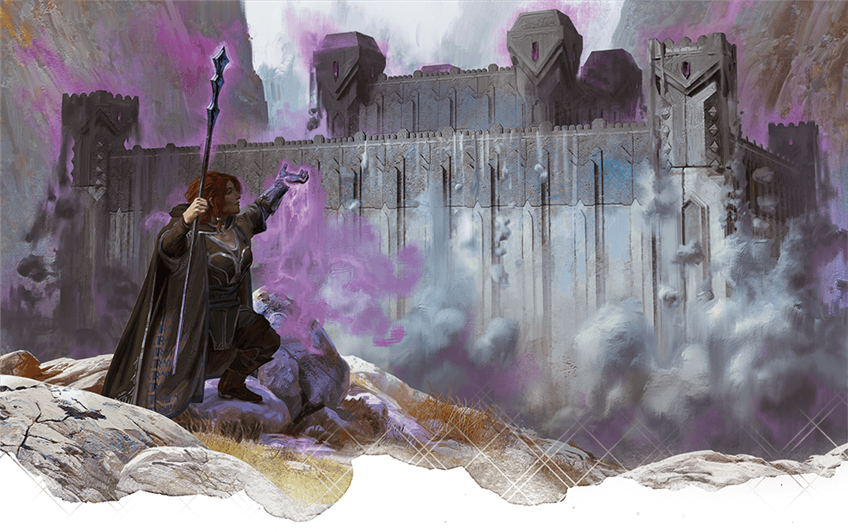
Story of the School of Conjuration
“What are you looking for?” A black-robed pupil, gaunt-faced and dark-eyed from lack of sleep, walked through rows of bookshelves, and looked up at a friend, a fellow pupil, who stood on the top rung of a rolling ladder attached to one of the shelves. The other pupil, swimming in ill-fitting orange robes, ran her finger along the spines of the leather bound tomes on the top shelf.
“A Catalogue of Lesser Elementals, Volume One, have you ever read it?” the other pupil responded. Sewn upon her robes was a symbol like an inverted A, with a wavy line cutting through the triangle—the magical glyph of conjuration.
The other pupil, whose black robes bore the omega-like glyph of necromancy, shook his head. “Ought I to have? Elementals play precious little role in my studies.”
“Oh, you’re useless,” the conjurer sighed, a hint of playfulness twinkling in her tone of frustration.
“You’re not going to do anything stupid with it, if you get it?” the necromancer said dully. “Because… I picked up a new divination over the weekend. I could help find it, if—”
“Would you?” The conjurer looked sharply over her shoulder, beaming at her friend. She turned with such force that she practically slipped from the ladder. She gasped as her foot slipped from the rung, then took a sharp breath in as she stabilized herself. The necromancer took a step forward, his hands open, grimacing, as he tried to remember if he’d prepared feather fall that morning. The conjurer laughed sheepishly. “I’m fine, I’m fine… but, seriously, would you?”
“If,” the necromancer continued unsteadily, “if you promise you’re not going to conjure another cloud of steam mephits in my dorm again. Half my spellbook’s pages are still wrinkled.”
“I’m not looking for little mephits,” the conjurer said, returning to scanning the spines of books. “An azer… I’ve always wanted to speak with an azer. They’re intelligent, skillful, they live on the Elemental Plane of Fire! They—!”
“Please spare me your effusiveness,” the necromancer sighed, though he couldn’t conceal the glint of excitement in his eyes at the thought of watching the illicit summoning an extraplanar being. And an intelligent one at that. “Fine, I’ll do it.” He left aloft his arcane focus, a silver key with a skull at the tip, and muttered an incantation, then spoke aloud the name of the tome. A flash of insight entered the wizard’s mind, and he pointed at the middle of a shelf three rows down. “The book you seek… it’s there.”
“Yes!” the conjurer whooped, and vanished in a cloud of silvery mist, appearing seconds later at the point the necromancer had gestured to. Another group of arcane pupils squeaked in surprise as the conjurer appeared among them, and fled the aisle. The necromancer smiled. His friend would get them into trouble again, he was certain, but it would be worth it.
School of Conjuration Features
Conjurers are talented practitioners of the magic of summoning and creation, through which they can transport items and creatures, or even create matter or energy out of thin air. The wizard gains five subclass features at 2nd, 6th, 10th, and 14th level. You can read all of the School of Abjuration features in the Player’s Handbook. In summary, your subclass features allow you to:
- Study conjuration spells more efficiently, halving the time and cost of copying such spells into your spellbook
- Temporarily create objects out of raw magic
- Teleport within 30 feet, or swap places with another willing creature
- Maintain perfect concentration on your conjuration spells
- Grant your conjured creatures additional durability
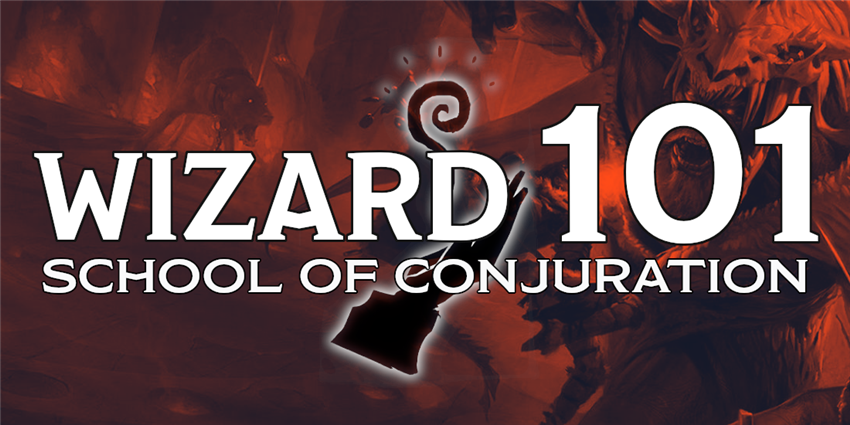
Benefits of the School of Conjuration
Conjuration magic is available to all wizards, but those wizards who specifically study this spell school’s intricacies can enhance their conjurations in ways other spellcasters can only dream of. These benefits, such as being unable to lose concentration on conjuration spells, and giving summoned creatures additional hit points, make you the undisputed master of conjuration spells. Other wizards might be able to use the same spells as you, but they’ll never be quite as good as you at them.
Your earlier class features, such as Minor Conjuration and Benign Teleportation, aren’t raw upgrades to your spells in the way that your higher-level features are, but they’re useful at reinforcing the flavor of your class. Conjuration is about both creation and transportation, and these two features nail those aspects of the conjurer class fantasy. Minor Conjuration is a fun way to solve problems by conjuring a tool that will let you use an imaginative solution. You could conjure a crowbar to pry open a stuck door, a shortsword for a disarmed fighter, a set of thieves’ tools for a rogue who’s lost their lockpicks, a padlock to secure a door, a locket with a secret compartment to hide a letter, or whatever else you can think of.
Your Benign Transposition feature also has a number of applications, combat and while exploring—and with some creative thinking, maybe even in social scenarios. Being able to swap places with your fighter companion when you’re caught off guard by an ambush is fantastic. Casting fly on yourself and using that spell in conjunction with this feature to ferry a friend across a dangerous chasm is useful, too! Get creative with this feature, though do be mindful of its 30-foot range and its once-per-long-rest restriction, though even that is malleable, as long as you’re casting lots of conjuration spells.
Drawbacks of the School of Conjuration
One of the great drawbacks of specializing in conjuration spells is that so many spells in that school require your concentration. Your ability to only concentrate on a single spell at a time isn’t too oppressive at low levels, since there are quite a few useful spells like grease, find familiar, and misty step which don’t require concentration. However, as you gain levels, you’ll find that your most exciting spells, particularly those which summon creatures to fight for you, all demand your precious concentration slot.
Your Focused Conjuration feature, which prevents your concentration on conjuration spells from being broken when you take damage, helps keep your summoned creatures from disappearing in the heat of combat because you lost concentration, but it does little to ease the pain of only being able to focus on one powerful conjuration spell at a time.
If you plan on playing a School of Conjuration wizard, be sure to take some spells outside of your school of focus. While you want to have a plentiful supply of conjuration spells to refresh your Benign Transposition feature, and to benefit from your Focused Conjuration feature, don’t forget to carry a diverse toolkit of spells. While being powerful within your niche is a good quality for any wizard to have, the real strength of your class is having the right tool for any occasion—and overloading your prepared spell list with too many summoning spells will make it hard for you to be flexible.
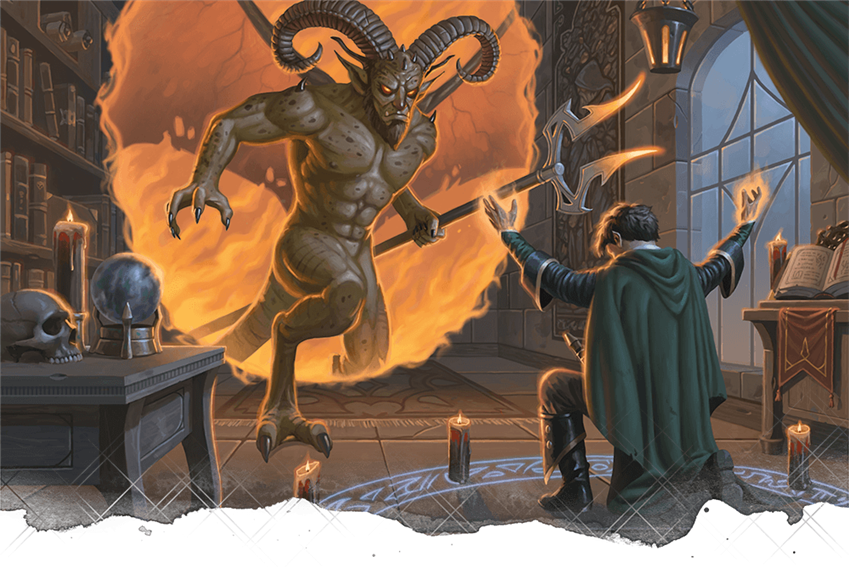
Suggested Build
As a wizard, you choose your Arcane Tradition at 2nd level. This gives you a little bit of time to feel out what you want your playstyle to be before you select your preferred subclass. You may find that your spells feel a little lackluster at 1st level, since you only have two 1st-level spell slots to use before falling back on your cantrips. Even using your Arcane Recovery feature to get one 1st-level slot back during a short rest, your cantrips may seem like they’re the star of the show. That’s fine! As you gain levels, you’ll gain more and more spell slots, and in time you won’t have to fall back on simple cantrips.
You should choose a race that improves your Intelligence score, and either your Dexterity or Constitution scores. As a wizard, Intelligence is your most important ability. Your spells are powered by your own knowledge of the arcane workings of magic, and improving this understanding makes it easier for you to hit with spell attacks and harder for enemies to save against your spells. As such, gnomes make fantastic wizards, as their innate intellect makes them natural studies. High elves also make excellent wizards, as they gain a natural bonus to both Dexterity and Intelligence, and also grant you an extra cantrip. Variant humans also have a good time as wizards; gaining a free feat is nothing to sneeze at.
Choose EQUIPMENT instead of GOLD at the end of character creation. Since you’ll probably be choosing at least one ranged damage-dealing cantrip, you can take a quarterstaff so that you have a little bit of protection up-close. Choosing a component pouch or an arcane focus is a purely aesthetic choice, and choosing a scholar’s or an explorer’s pack is a fairly insignificant decision. A scholar’s pack will be useful in a more city-based campaign, but if you plan on traveling cross-country, then an explorer’s pack is the superior choice.
Spells
Wizards can copy so many spells into their spellbook that you don’t have to be too choosey when selecting your spells at each level. Nevertheless, it couldn’t hurt to make very clear choices, especially if your DM doesn’t give out a lot of spell scrolls to copy, or doesn’t pit you against many other enemy wizards with spellbooks to steal. As a 1st-level wizard, your spellbook starts with six spells in it, and you can prepare a number of spells equal to Intelligence modifier + your wizard level (minimum of one spell). Don’t forget that all of these spells must come from the wizard spell list. You also start play with 3 cantrips, also from the wizard spell list. You gain two new wizard spells every level, and you also gain new cantrips from time to time, so keep an eye on the Wizard Table when you gain a new level.
As a conjurer, you’ll want at least two spells marked DEFENSE, one spell marked either OFFENSE, and one spell marked either SOCIAL or SUPPORT, depending on how you want to play your character. Spells on this list from the conjuration school are also noted, since they can be used to refresh your Benign Transposition feature, starting at 6th level.
Note that this list only includes some spells from the Player's Handbook, so if you want to choose more unusual spells, or have other sources like Xanathar's Guide to Everything, you'll have to do a little self-directed research. This list is just here to get you started if this is your first time playing a conjurer.
- Burning hands (OFFENSE)
- Charm person (SOCIAL)
- Detect magic (EXPLORATION)
- Disguise self (SOCIAL)
- Fog cloud (DEFENSE; conjuration)
- Find familiar (OFFENSE/EXPLORATION; conjuration)
- Mage armor (DEFENSE)
- Grease (DEFENSE; conjuration)
- Thunderwave (OFFENSE)

Feats
Once you’ve improved your Intelligence score to 18 or 20, you can increase your power with a few useful feats. The following feats are good picks for School of Conjuration wizards, and will improve your reliability in your own desired area of expertise:
Conjurers don’t have any feats that they desperately want, so focus mainly on improving your Intelligence score. Some feats like Keen Mind, Linguist, and Observant can give you a fun character quirk while still giving you a minor boost to your Intelligence, but don’t pick these unless they support your character concept.
If you want more advice for building a wizard, check out Wizard 101. Have you ever played a School of Conjuration wizard? What advice would you give to players that want to play this subclass? Join us next week as we begin a new slate of Class 101 articles in Artificer 101: Alchemist!
Create A Brand-New Adventurer Acquire New Powers and Adventures Browse All Your D&D Content
 James Haeck is the lead writer for D&D Beyond, the co-author of Waterdeep: Dragon Heist, Baldur's Gate: Descent into Avernus, and the Critical Role Explorer's Guide to Wildemount, a member of the Guild Adepts, and a freelance writer for Wizards of the Coast, the D&D Adventurers League, and other RPG companies. He lives in Seattle, Washington with his fiancée Hannah and their animal companions Mei and Marzipan. You can find him wasting time on Twitter at @jamesjhaeck.
James Haeck is the lead writer for D&D Beyond, the co-author of Waterdeep: Dragon Heist, Baldur's Gate: Descent into Avernus, and the Critical Role Explorer's Guide to Wildemount, a member of the Guild Adepts, and a freelance writer for Wizards of the Coast, the D&D Adventurers League, and other RPG companies. He lives in Seattle, Washington with his fiancée Hannah and their animal companions Mei and Marzipan. You can find him wasting time on Twitter at @jamesjhaeck.








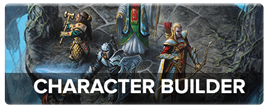
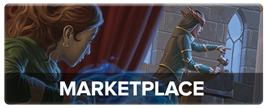
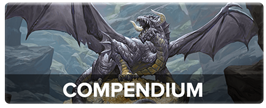
-
View User Profile
-
Send Message
Posted Nov 11, 2020I loved that little story at the beginning. There just aren't enough positive depictions of necromancers in the world.
-
View User Profile
-
Send Message
Posted Nov 12, 2020Can't you just make diamonds with minor conjuration for cleric to cast revivify and trivialize the spell cost economy?
-
View User Profile
-
Send Message
Posted Nov 12, 2020No, you can conjure a diamond but it isn’t worth anything for the purposes of spell components
-
View User Profile
-
Send Message
Posted Nov 12, 2020She's level 14, and managed to defeat a BBEG beholder collector who had a massive amount of gems on it. Finally had wealth to sustain the binding for a decent time! Level 7 summon, then a level 6 binding, then a level 7 binding a few days later! Hoping she survives enemies and the party paladin (who isn't keen)!
-
View User Profile
-
Send Message
Posted Nov 12, 2020You know what would be fun though: a conjurer who uses neither a component pouch nor an arcane focus - they just conjure up any (non - costly) components they need. Also: you don't need to worry about components that are consumed but not costly!
-
View User Profile
-
Send Message
Posted Nov 13, 2020I thought about that, you would have to talk with your dm about it tho since technically it’s and action to conjure something so it would have to be a purely flavor change. As a dm I would rule it as you still have to have a component pouch on your person, but as flavor you just conjure things instead of pulling them from a pouch
-
View User Profile
-
Send Message
Posted Nov 14, 2020Conjuration wizards are so fun! It would be cool to high elf conjuration wizard 2/fighter 1, as you could summon a light crossbow with minor conjuration (wizards have proficiency in these) use action surge, shoot it then drop it! you could also create poison for the rogue in the party in the tense moment just before initiative, a shield for an injured character, money if ur a sneaky wizard, a one-man tent if you without shelter, a cloak with camouflage matching ur exact surroundings, or even an umbrella so you can take the hide action. The possibilities are endless!
-
View User Profile
-
Send Message
Posted Nov 14, 2020I love these little dnd life hacks. So inventive! My friend once used chill touch to flip the bird at the barmaid while he was reading. My other friend also made a tiny servant (a Xanathar’s spell) out of the rogues theives tools and they opened doors from a distance.
-
View User Profile
-
Send Message
Posted Nov 14, 2020Action Surge is a level 2 trait on fighters
-
View User Profile
-
Send Message
Posted Nov 16, 2020I was planning to play a this for a game.was really looking forward to it until I read the description of the minor conjuration feature the above example mentioned that you could create a weapon for a fighter but the power description states that the created item will vanish if the spell ends if you use this power again or if the item suffers or inflicts any damage. It seems a bit strange that the power has this drawback as numerous other options exist for summoning or creating weapon including magic ones while the specialist caster can in effect only create a single use imitation of a basics weapon. Honestly I feel like that could be a higher level power in the illusion school but a conjuration specialist should be able to bring a normal quality item weapon or shield in to being without the "made of glass" themed restrictions.
-
View User Profile
-
Send Message
Posted Nov 16, 2020For the non-magical dingus you create as part of the Minor Conjuration feature, could it be a roast chicken? if so, would you be hungry again after digesting it for the better part of an hour?
Something I've always wondered about with food on the ST:TNG holodeck.
-
View User Profile
-
Send Message
Posted Nov 16, 2020My favorite use of minor conjuration was that my character saw a stone ball in a dungeon, which was a two-feet radius, and then I used that same thing on dragons, beheirs, and one very sad group of skeletons. Also, because it is classified as magical, it can be considered a magical weapon when people attack with it against monsters resistant to non-magic damages. but it would do no extra damage because it has to copy non-magic items. and it only disappears when it takes, not gives damage.
-
View User Profile
-
Send Message
Posted Nov 17, 2020i'd rule that when you try to eat it that would inflict damage on it thus ending the effect. as for holodeck.....? good question, i'd assume that the food as with the other characters on the holodeck are comprised of light and forcefealds so you could i suspect feel satisfied after a meal but get zero nutritional value from it and yes you would feel the .... dam I just realized that the collapsing forcefeald bubbles in side you could be very painfull.
-
View User Profile
-
Send Message
Posted Nov 17, 2020-
View User Profile
-
Send Message
Posted Nov 17, 2020i'd rule that when you try to eat it that would inflict damage on it thus ending the effect. as for holodeck.....? good question, i'd assume that the food as with the other characters on the holodeck are comprised of light and forcefealds so you could i suspect feel satisfied after a meal but get zero nutritional value from it and yes you would feel the .... dam I just realized that the collapsing forcefeald bubbles in side you could be very painfull.
-
View User Profile
-
Send Message
Posted Nov 17, 2020Canonically, stuff on the holodeck like food is generally generated by replicators.
-
View User Profile
-
Send Message
Posted Nov 17, 2020Actually canonically the holodeck works differently season to season and show to show 😝
In Voyager they talk about force fields and forced perspective, but in TNG they mention it being like the transporter/replicator, and that's when they try not to make it just sound like magic, or ignore how it works entirely. If it's like a replicator then food on the holodeck can indeed be real, in which case the more of it you eat, the more expensive it becomes to run the holodeck. But the holodeck isn't an ideal comparison, as objects within it don't have a hard duration; if power isn't a concern then you can stay on a holodeck for days at a time.
For minor conjuration I'd say that conjured food is of no use personally; it's only described as being in the "form" of something you choose, not that it actually is that object. While it's reasonable to think that it might share some of the basic physical properties (a solid object is solid, clothes are wearable etc.), whatever you choose is "visibly magical" which suggests it's not real in any other way that might matter.
-
View User Profile
-
Send Message
Posted Nov 19, 2020I suppose it's open to interpretation. A common crowbar created by Minor Conjuration can pry open a stuck door, and do things that crowbars generally do, but ceases to be a crowbar after an hour and can no longer do those things.
A roasted bird may be too complex, due to heat and spices. Or it may be bland. But as it would cease to be a roast bird after one hour, it sure would make for easy cleanup at a holiday dinner.
-
View User Profile
-
Send Message
Posted Nov 19, 2020It would also mean that you're hungry again.
-
View User Profile
-
Send Message
Posted Nov 19, 2020All a crowbar requires in order to function is to be the correct shape and solid, but for a meal to "work" it needs to contain nutrients and be able to break down etc.
I mean it's ultimately up to a DM, but to me the feature sounds like a conjured object only really has a superficial resemblance to the original; it might look and feel like the original, but may not go deeper than this. It's very strange that the feature is so loosely worded when similar spells are a lot more specific, and it never seems to have been errata'd or clarified which doesn't help.